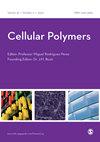Porous synthetic hydrogel carrying basic fibroblast growth factor with controllable and rapid degradation rate to promote wound healing
IF 1.3
4区 医学
Q4 MATERIALS SCIENCE, BIOMATERIALS
引用次数: 0
Abstract
Porous hydrogel dressings show breathability and possibility to carry and release basic fibroblast growth factor (bFGF) to promote wound healing. However, the difficult replacement may lead to the secondary damage. Thus, there is an urgent need to develop a method platform to control the degradation rate of hydrogel, so as to realize the on-demand replacement. The present study fabricated a porous hydrogel from co-polymized N,N′-bis(acryloyl) cystamine (BAC), allyl polyethylene glycol 500 (APEG500) and acrylic acid (AA) with the presence of polycaprolactone (PCL). BAC contains disulfide bond, which crosslinked the hydrogel. The pore size of the porous hydrogel was 400–600 μm. Higher content of BAC indicated higher crosslinking density, which reduced swelling ratio of hydrogel, while promoted hydrogel storage modulus. At the same time, the presence of PCL reduced swelling ratio of hydrogel, while promoted hydrogel mechanical properties, endowing hydrogel with tough feature. Porous hydrogels that crosslinked by disulfide bonds immersed in glutathione solution were found to degrade spontaneously and quickly due to the response to glutathione. Both crosslinking density and PCL content affected the degradation rate. The porous hydrogel carrying bFGF was applied to wound, promoting angiogenesis, thus accelerating wound healing within 12 d. Due to the spontaneous and rapid degradation of optimized porous hydrogel on wound within 3 days, there was no operation of removing dressing during treatment, avoiding damage during dressing replacement.多孔合成水凝胶携带碱性成纤维细胞生长因子,降解速度可控、快速,促进伤口愈合
多孔水凝胶敷料显示出透气性和携带和释放碱性成纤维细胞生长因子(bFGF)以促进伤口愈合的可能性。然而,更换困难可能会导致二次损坏。因此,迫切需要开发一种控制水凝胶降解速率的方法平台,以实现按需更换。本研究以N,N′-双(丙烯酰基)胱胺(BAC)、烯丙基聚乙二醇500(APEG500)和丙烯酸(AA)为原料,在聚己内酯(PCL)的存在下制备了多孔水凝胶。BAC含有使水凝胶交联的二硫键。多孔水凝胶的孔径为400–600μm。BAC含量越高,交联密度越高,降低了水凝胶的溶胀率,同时提高了水凝胶的储能模量。同时,PCL的存在降低了水凝胶的溶胀率,同时提高了水凝胶的力学性能,赋予水凝胶坚韧的特性。通过浸入谷胱甘肽溶液中的二硫键交联的多孔水凝胶被发现由于对谷胱甘肽的反应而自发快速降解。交联密度和PCL含量均影响降解速率。将携带bFGF的多孔水凝胶应用于伤口,促进血管生成,从而在12天内加速伤口愈合。由于优化的多孔水凝胶在3天内在伤口上自发快速降解,因此在治疗过程中没有移除敷料的操作,避免了敷料更换过程中的损伤。
本文章由计算机程序翻译,如有差异,请以英文原文为准。
求助全文
约1分钟内获得全文
求助全文
来源期刊

Cellular Polymers
工程技术-材料科学:生物材料
CiteScore
3.10
自引率
0.00%
发文量
9
审稿时长
3 months
期刊介绍:
Cellular Polymers is concerned primarily with the science of foamed materials, the technology and state of the art for processing and fabricating, the engineering techniques and principles of the machines used to produce them economically, and their applications in varied and wide ranging uses where they are making an increasingly valuable contribution.
Potential problems for the industry are also covered, including fire performance of materials, CFC-replacement technology, recycling and environmental legislation. Reviews of technical and commercial advances in the manufacturing and application technologies are also included.
Cellular Polymers covers these and other related topics and also pays particular attention to the ways in which the science and technology of cellular polymers is being developed throughout the world.
 求助内容:
求助内容: 应助结果提醒方式:
应助结果提醒方式:


